System Thinking Application: Analyzing Australia's Aging Workforce
VerifiedAdded on 2023/06/07
|7
|2948
|449
Essay
AI Summary
This essay discusses the application of system thinking to address sustainability challenges, particularly focusing on the issue of Australia's aging workforce. It highlights the limitations of traditional problem-solving approaches and advocates for system thinking's ability to consider the interconnections between various factors, such as economic, social, and ecological elements. The essay analyzes the characteristics of the aging workforce as a 'wicked problem,' detailing the increasing proportion of older Australians and its potential impacts on economic growth, government spending, and social security. It further explores the changes needed in macroeconomic and microeconomic policies to address these challenges, including adjustments to taxation, healthcare, and education. The essay concludes by emphasizing the need for a national strategy that promotes self-provision, healthy aging, and world-class care to mitigate the adverse effects of an aging population on Australia's economy and society.
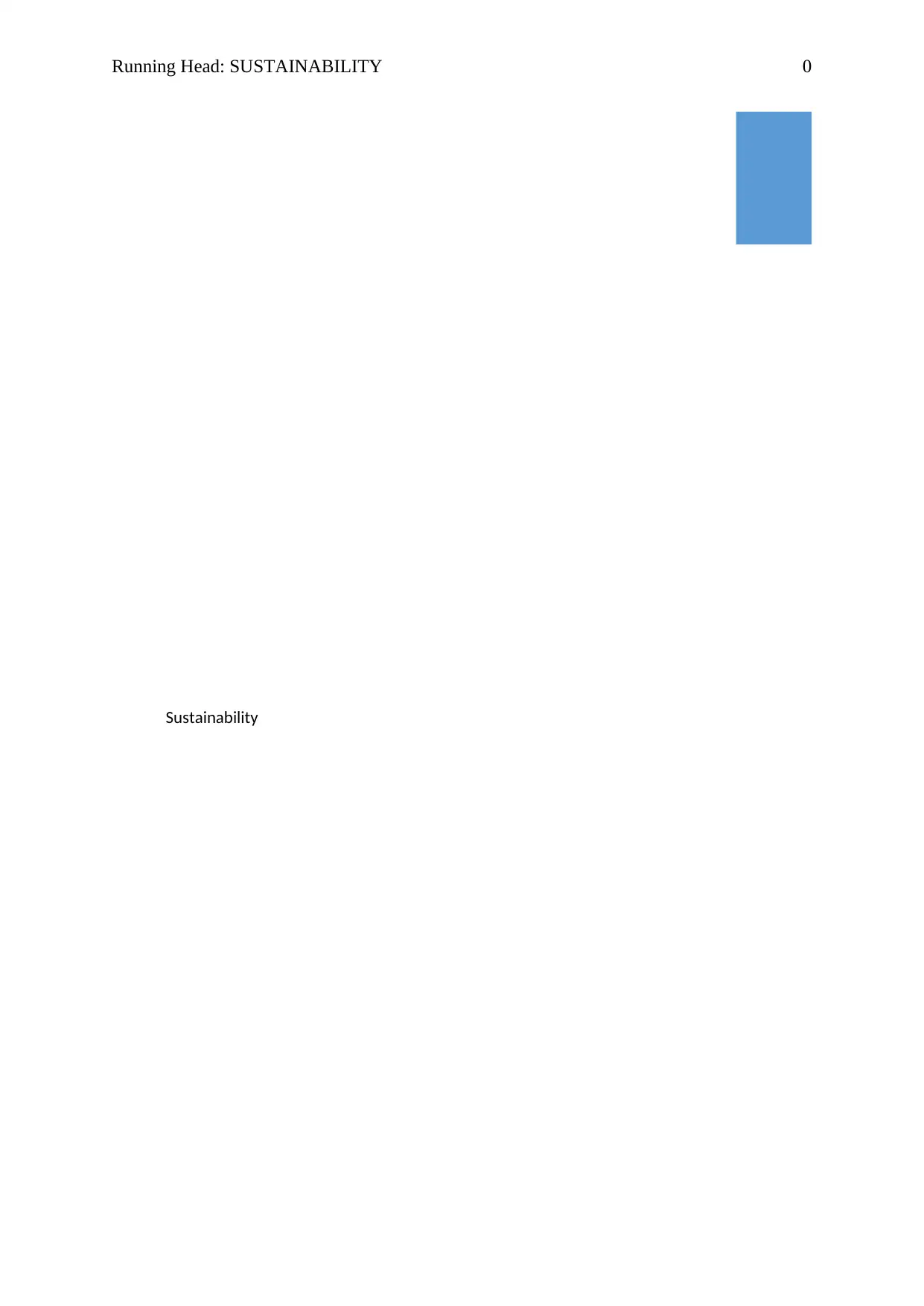
Running Head: SUSTAINABILITY 0
Sustainability
Sustainability
Paraphrase This Document
Need a fresh take? Get an instant paraphrase of this document with our AI Paraphraser
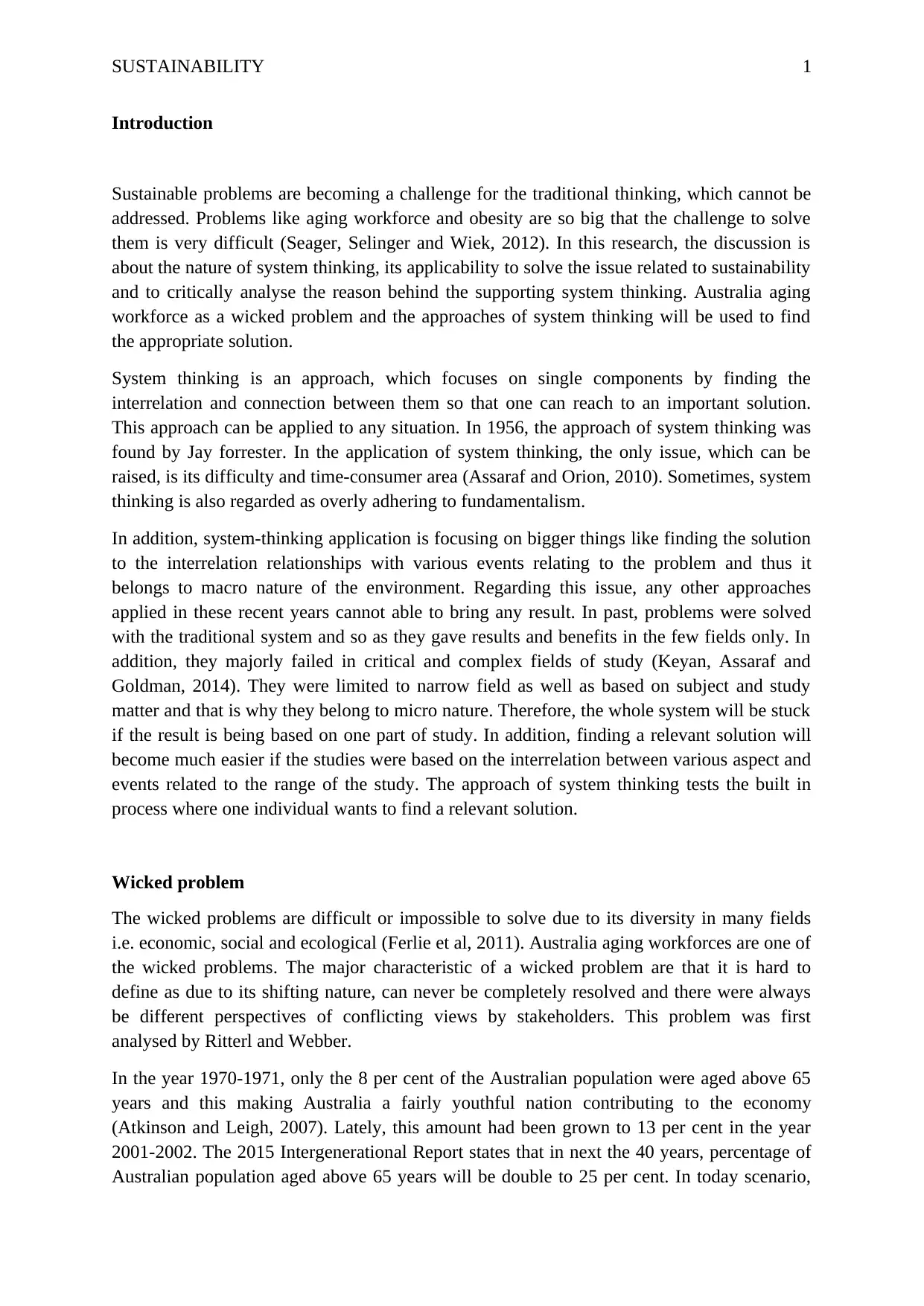
SUSTAINABILITY 1
Introduction
Sustainable problems are becoming a challenge for the traditional thinking, which cannot be
addressed. Problems like aging workforce and obesity are so big that the challenge to solve
them is very difficult (Seager, Selinger and Wiek, 2012). In this research, the discussion is
about the nature of system thinking, its applicability to solve the issue related to sustainability
and to critically analyse the reason behind the supporting system thinking. Australia aging
workforce as a wicked problem and the approaches of system thinking will be used to find
the appropriate solution.
System thinking is an approach, which focuses on single components by finding the
interrelation and connection between them so that one can reach to an important solution.
This approach can be applied to any situation. In 1956, the approach of system thinking was
found by Jay forrester. In the application of system thinking, the only issue, which can be
raised, is its difficulty and time-consumer area (Assaraf and Orion, 2010). Sometimes, system
thinking is also regarded as overly adhering to fundamentalism.
In addition, system-thinking application is focusing on bigger things like finding the solution
to the interrelation relationships with various events relating to the problem and thus it
belongs to macro nature of the environment. Regarding this issue, any other approaches
applied in these recent years cannot able to bring any result. In past, problems were solved
with the traditional system and so as they gave results and benefits in the few fields only. In
addition, they majorly failed in critical and complex fields of study (Keyan, Assaraf and
Goldman, 2014). They were limited to narrow field as well as based on subject and study
matter and that is why they belong to micro nature. Therefore, the whole system will be stuck
if the result is being based on one part of study. In addition, finding a relevant solution will
become much easier if the studies were based on the interrelation between various aspect and
events related to the range of the study. The approach of system thinking tests the built in
process where one individual wants to find a relevant solution.
Wicked problem
The wicked problems are difficult or impossible to solve due to its diversity in many fields
i.e. economic, social and ecological (Ferlie et al, 2011). Australia aging workforces are one of
the wicked problems. The major characteristic of a wicked problem are that it is hard to
define as due to its shifting nature, can never be completely resolved and there were always
be different perspectives of conflicting views by stakeholders. This problem was first
analysed by Ritterl and Webber.
In the year 1970-1971, only the 8 per cent of the Australian population were aged above 65
years and this making Australia a fairly youthful nation contributing to the economy
(Atkinson and Leigh, 2007). Lately, this amount had been grown to 13 per cent in the year
2001-2002. The 2015 Intergenerational Report states that in next the 40 years, percentage of
Australian population aged above 65 years will be double to 25 per cent. In today scenario,
Introduction
Sustainable problems are becoming a challenge for the traditional thinking, which cannot be
addressed. Problems like aging workforce and obesity are so big that the challenge to solve
them is very difficult (Seager, Selinger and Wiek, 2012). In this research, the discussion is
about the nature of system thinking, its applicability to solve the issue related to sustainability
and to critically analyse the reason behind the supporting system thinking. Australia aging
workforce as a wicked problem and the approaches of system thinking will be used to find
the appropriate solution.
System thinking is an approach, which focuses on single components by finding the
interrelation and connection between them so that one can reach to an important solution.
This approach can be applied to any situation. In 1956, the approach of system thinking was
found by Jay forrester. In the application of system thinking, the only issue, which can be
raised, is its difficulty and time-consumer area (Assaraf and Orion, 2010). Sometimes, system
thinking is also regarded as overly adhering to fundamentalism.
In addition, system-thinking application is focusing on bigger things like finding the solution
to the interrelation relationships with various events relating to the problem and thus it
belongs to macro nature of the environment. Regarding this issue, any other approaches
applied in these recent years cannot able to bring any result. In past, problems were solved
with the traditional system and so as they gave results and benefits in the few fields only. In
addition, they majorly failed in critical and complex fields of study (Keyan, Assaraf and
Goldman, 2014). They were limited to narrow field as well as based on subject and study
matter and that is why they belong to micro nature. Therefore, the whole system will be stuck
if the result is being based on one part of study. In addition, finding a relevant solution will
become much easier if the studies were based on the interrelation between various aspect and
events related to the range of the study. The approach of system thinking tests the built in
process where one individual wants to find a relevant solution.
Wicked problem
The wicked problems are difficult or impossible to solve due to its diversity in many fields
i.e. economic, social and ecological (Ferlie et al, 2011). Australia aging workforces are one of
the wicked problems. The major characteristic of a wicked problem are that it is hard to
define as due to its shifting nature, can never be completely resolved and there were always
be different perspectives of conflicting views by stakeholders. This problem was first
analysed by Ritterl and Webber.
In the year 1970-1971, only the 8 per cent of the Australian population were aged above 65
years and this making Australia a fairly youthful nation contributing to the economy
(Atkinson and Leigh, 2007). Lately, this amount had been grown to 13 per cent in the year
2001-2002. The 2015 Intergenerational Report states that in next the 40 years, percentage of
Australian population aged above 65 years will be double to 25 per cent. In today scenario,
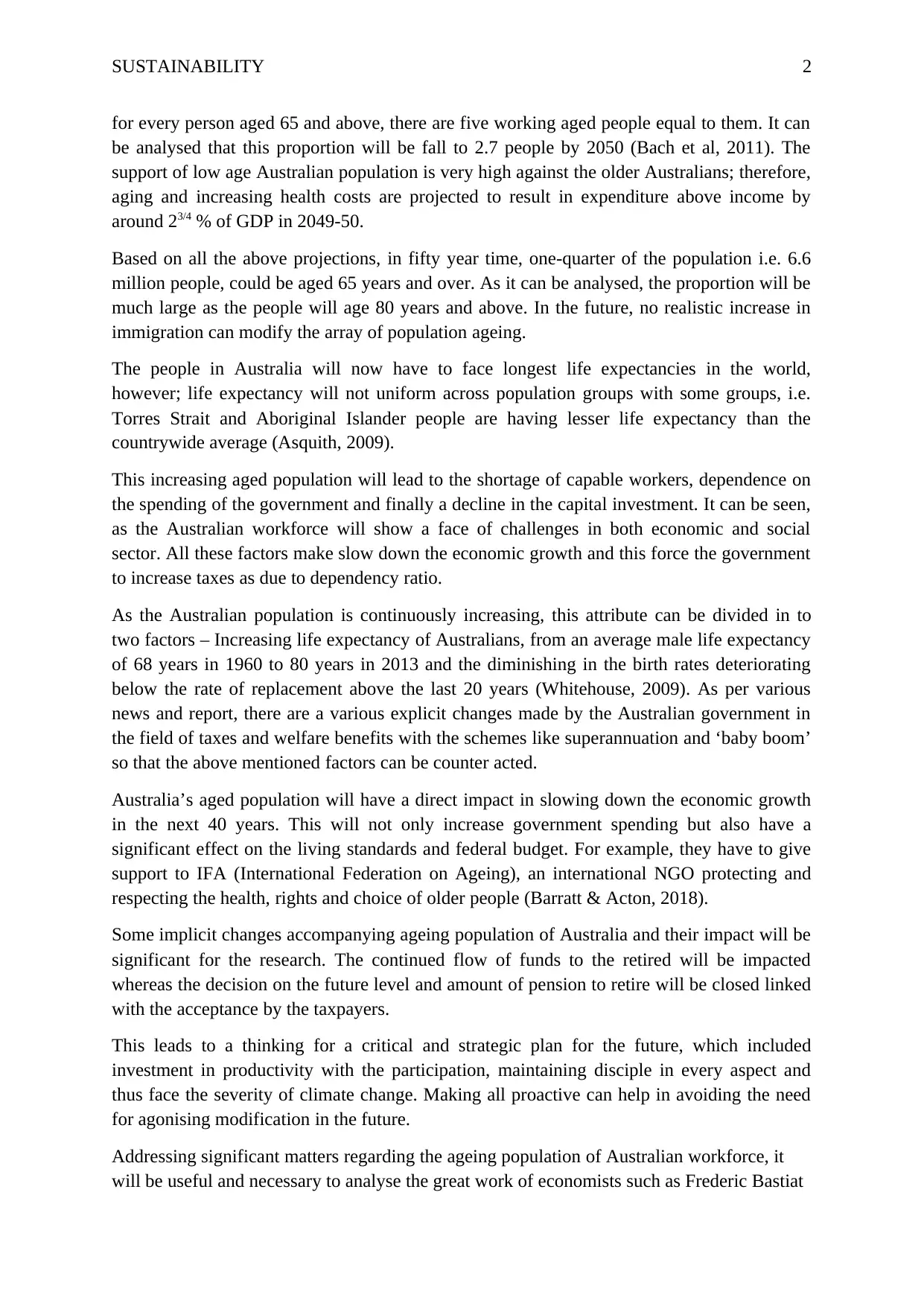
SUSTAINABILITY 2
for every person aged 65 and above, there are five working aged people equal to them. It can
be analysed that this proportion will be fall to 2.7 people by 2050 (Bach et al, 2011). The
support of low age Australian population is very high against the older Australians; therefore,
aging and increasing health costs are projected to result in expenditure above income by
around 23/4 % of GDP in 2049-50.
Based on all the above projections, in fifty year time, one-quarter of the population i.e. 6.6
million people, could be aged 65 years and over. As it can be analysed, the proportion will be
much large as the people will age 80 years and above. In the future, no realistic increase in
immigration can modify the array of population ageing.
The people in Australia will now have to face longest life expectancies in the world,
however; life expectancy will not uniform across population groups with some groups, i.e.
Torres Strait and Aboriginal Islander people are having lesser life expectancy than the
countrywide average (Asquith, 2009).
This increasing aged population will lead to the shortage of capable workers, dependence on
the spending of the government and finally a decline in the capital investment. It can be seen,
as the Australian workforce will show a face of challenges in both economic and social
sector. All these factors make slow down the economic growth and this force the government
to increase taxes as due to dependency ratio.
As the Australian population is continuously increasing, this attribute can be divided in to
two factors – Increasing life expectancy of Australians, from an average male life expectancy
of 68 years in 1960 to 80 years in 2013 and the diminishing in the birth rates deteriorating
below the rate of replacement above the last 20 years (Whitehouse, 2009). As per various
news and report, there are a various explicit changes made by the Australian government in
the field of taxes and welfare benefits with the schemes like superannuation and ‘baby boom’
so that the above mentioned factors can be counter acted.
Australia’s aged population will have a direct impact in slowing down the economic growth
in the next 40 years. This will not only increase government spending but also have a
significant effect on the living standards and federal budget. For example, they have to give
support to IFA (International Federation on Ageing), an international NGO protecting and
respecting the health, rights and choice of older people (Barratt & Acton, 2018).
Some implicit changes accompanying ageing population of Australia and their impact will be
significant for the research. The continued flow of funds to the retired will be impacted
whereas the decision on the future level and amount of pension to retire will be closed linked
with the acceptance by the taxpayers.
This leads to a thinking for a critical and strategic plan for the future, which included
investment in productivity with the participation, maintaining disciple in every aspect and
thus face the severity of climate change. Making all proactive can help in avoiding the need
for agonising modification in the future.
Addressing significant matters regarding the ageing population of Australian workforce, it
will be useful and necessary to analyse the great work of economists such as Frederic Bastiat
for every person aged 65 and above, there are five working aged people equal to them. It can
be analysed that this proportion will be fall to 2.7 people by 2050 (Bach et al, 2011). The
support of low age Australian population is very high against the older Australians; therefore,
aging and increasing health costs are projected to result in expenditure above income by
around 23/4 % of GDP in 2049-50.
Based on all the above projections, in fifty year time, one-quarter of the population i.e. 6.6
million people, could be aged 65 years and over. As it can be analysed, the proportion will be
much large as the people will age 80 years and above. In the future, no realistic increase in
immigration can modify the array of population ageing.
The people in Australia will now have to face longest life expectancies in the world,
however; life expectancy will not uniform across population groups with some groups, i.e.
Torres Strait and Aboriginal Islander people are having lesser life expectancy than the
countrywide average (Asquith, 2009).
This increasing aged population will lead to the shortage of capable workers, dependence on
the spending of the government and finally a decline in the capital investment. It can be seen,
as the Australian workforce will show a face of challenges in both economic and social
sector. All these factors make slow down the economic growth and this force the government
to increase taxes as due to dependency ratio.
As the Australian population is continuously increasing, this attribute can be divided in to
two factors – Increasing life expectancy of Australians, from an average male life expectancy
of 68 years in 1960 to 80 years in 2013 and the diminishing in the birth rates deteriorating
below the rate of replacement above the last 20 years (Whitehouse, 2009). As per various
news and report, there are a various explicit changes made by the Australian government in
the field of taxes and welfare benefits with the schemes like superannuation and ‘baby boom’
so that the above mentioned factors can be counter acted.
Australia’s aged population will have a direct impact in slowing down the economic growth
in the next 40 years. This will not only increase government spending but also have a
significant effect on the living standards and federal budget. For example, they have to give
support to IFA (International Federation on Ageing), an international NGO protecting and
respecting the health, rights and choice of older people (Barratt & Acton, 2018).
Some implicit changes accompanying ageing population of Australia and their impact will be
significant for the research. The continued flow of funds to the retired will be impacted
whereas the decision on the future level and amount of pension to retire will be closed linked
with the acceptance by the taxpayers.
This leads to a thinking for a critical and strategic plan for the future, which included
investment in productivity with the participation, maintaining disciple in every aspect and
thus face the severity of climate change. Making all proactive can help in avoiding the need
for agonising modification in the future.
Addressing significant matters regarding the ageing population of Australian workforce, it
will be useful and necessary to analyse the great work of economists such as Frederic Bastiat
⊘ This is a preview!⊘
Do you want full access?
Subscribe today to unlock all pages.

Trusted by 1+ million students worldwide
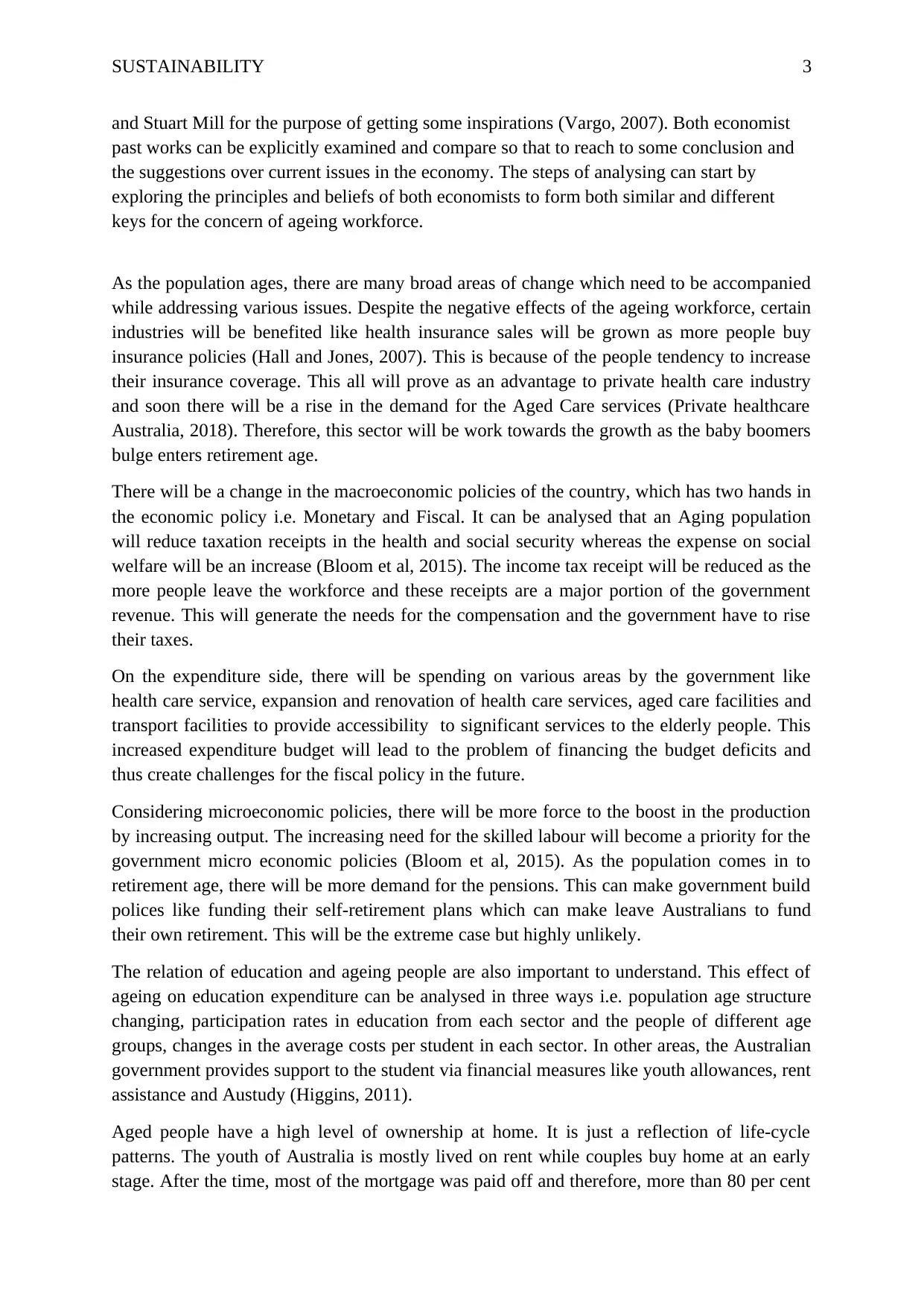
SUSTAINABILITY 3
and Stuart Mill for the purpose of getting some inspirations (Vargo, 2007). Both economist
past works can be explicitly examined and compare so that to reach to some conclusion and
the suggestions over current issues in the economy. The steps of analysing can start by
exploring the principles and beliefs of both economists to form both similar and different
keys for the concern of ageing workforce.
As the population ages, there are many broad areas of change which need to be accompanied
while addressing various issues. Despite the negative effects of the ageing workforce, certain
industries will be benefited like health insurance sales will be grown as more people buy
insurance policies (Hall and Jones, 2007). This is because of the people tendency to increase
their insurance coverage. This all will prove as an advantage to private health care industry
and soon there will be a rise in the demand for the Aged Care services (Private healthcare
Australia, 2018). Therefore, this sector will be work towards the growth as the baby boomers
bulge enters retirement age.
There will be a change in the macroeconomic policies of the country, which has two hands in
the economic policy i.e. Monetary and Fiscal. It can be analysed that an Aging population
will reduce taxation receipts in the health and social security whereas the expense on social
welfare will be an increase (Bloom et al, 2015). The income tax receipt will be reduced as the
more people leave the workforce and these receipts are a major portion of the government
revenue. This will generate the needs for the compensation and the government have to rise
their taxes.
On the expenditure side, there will be spending on various areas by the government like
health care service, expansion and renovation of health care services, aged care facilities and
transport facilities to provide accessibility to significant services to the elderly people. This
increased expenditure budget will lead to the problem of financing the budget deficits and
thus create challenges for the fiscal policy in the future.
Considering microeconomic policies, there will be more force to the boost in the production
by increasing output. The increasing need for the skilled labour will become a priority for the
government micro economic policies (Bloom et al, 2015). As the population comes in to
retirement age, there will be more demand for the pensions. This can make government build
polices like funding their self-retirement plans which can make leave Australians to fund
their own retirement. This will be the extreme case but highly unlikely.
The relation of education and ageing people are also important to understand. This effect of
ageing on education expenditure can be analysed in three ways i.e. population age structure
changing, participation rates in education from each sector and the people of different age
groups, changes in the average costs per student in each sector. In other areas, the Australian
government provides support to the student via financial measures like youth allowances, rent
assistance and Austudy (Higgins, 2011).
Aged people have a high level of ownership at home. It is just a reflection of life-cycle
patterns. The youth of Australia is mostly lived on rent while couples buy home at an early
stage. After the time, most of the mortgage was paid off and therefore, more than 80 per cent
and Stuart Mill for the purpose of getting some inspirations (Vargo, 2007). Both economist
past works can be explicitly examined and compare so that to reach to some conclusion and
the suggestions over current issues in the economy. The steps of analysing can start by
exploring the principles and beliefs of both economists to form both similar and different
keys for the concern of ageing workforce.
As the population ages, there are many broad areas of change which need to be accompanied
while addressing various issues. Despite the negative effects of the ageing workforce, certain
industries will be benefited like health insurance sales will be grown as more people buy
insurance policies (Hall and Jones, 2007). This is because of the people tendency to increase
their insurance coverage. This all will prove as an advantage to private health care industry
and soon there will be a rise in the demand for the Aged Care services (Private healthcare
Australia, 2018). Therefore, this sector will be work towards the growth as the baby boomers
bulge enters retirement age.
There will be a change in the macroeconomic policies of the country, which has two hands in
the economic policy i.e. Monetary and Fiscal. It can be analysed that an Aging population
will reduce taxation receipts in the health and social security whereas the expense on social
welfare will be an increase (Bloom et al, 2015). The income tax receipt will be reduced as the
more people leave the workforce and these receipts are a major portion of the government
revenue. This will generate the needs for the compensation and the government have to rise
their taxes.
On the expenditure side, there will be spending on various areas by the government like
health care service, expansion and renovation of health care services, aged care facilities and
transport facilities to provide accessibility to significant services to the elderly people. This
increased expenditure budget will lead to the problem of financing the budget deficits and
thus create challenges for the fiscal policy in the future.
Considering microeconomic policies, there will be more force to the boost in the production
by increasing output. The increasing need for the skilled labour will become a priority for the
government micro economic policies (Bloom et al, 2015). As the population comes in to
retirement age, there will be more demand for the pensions. This can make government build
polices like funding their self-retirement plans which can make leave Australians to fund
their own retirement. This will be the extreme case but highly unlikely.
The relation of education and ageing people are also important to understand. This effect of
ageing on education expenditure can be analysed in three ways i.e. population age structure
changing, participation rates in education from each sector and the people of different age
groups, changes in the average costs per student in each sector. In other areas, the Australian
government provides support to the student via financial measures like youth allowances, rent
assistance and Austudy (Higgins, 2011).
Aged people have a high level of ownership at home. It is just a reflection of life-cycle
patterns. The youth of Australia is mostly lived on rent while couples buy home at an early
stage. After the time, most of the mortgage was paid off and therefore, more than 80 per cent
Paraphrase This Document
Need a fresh take? Get an instant paraphrase of this document with our AI Paraphraser
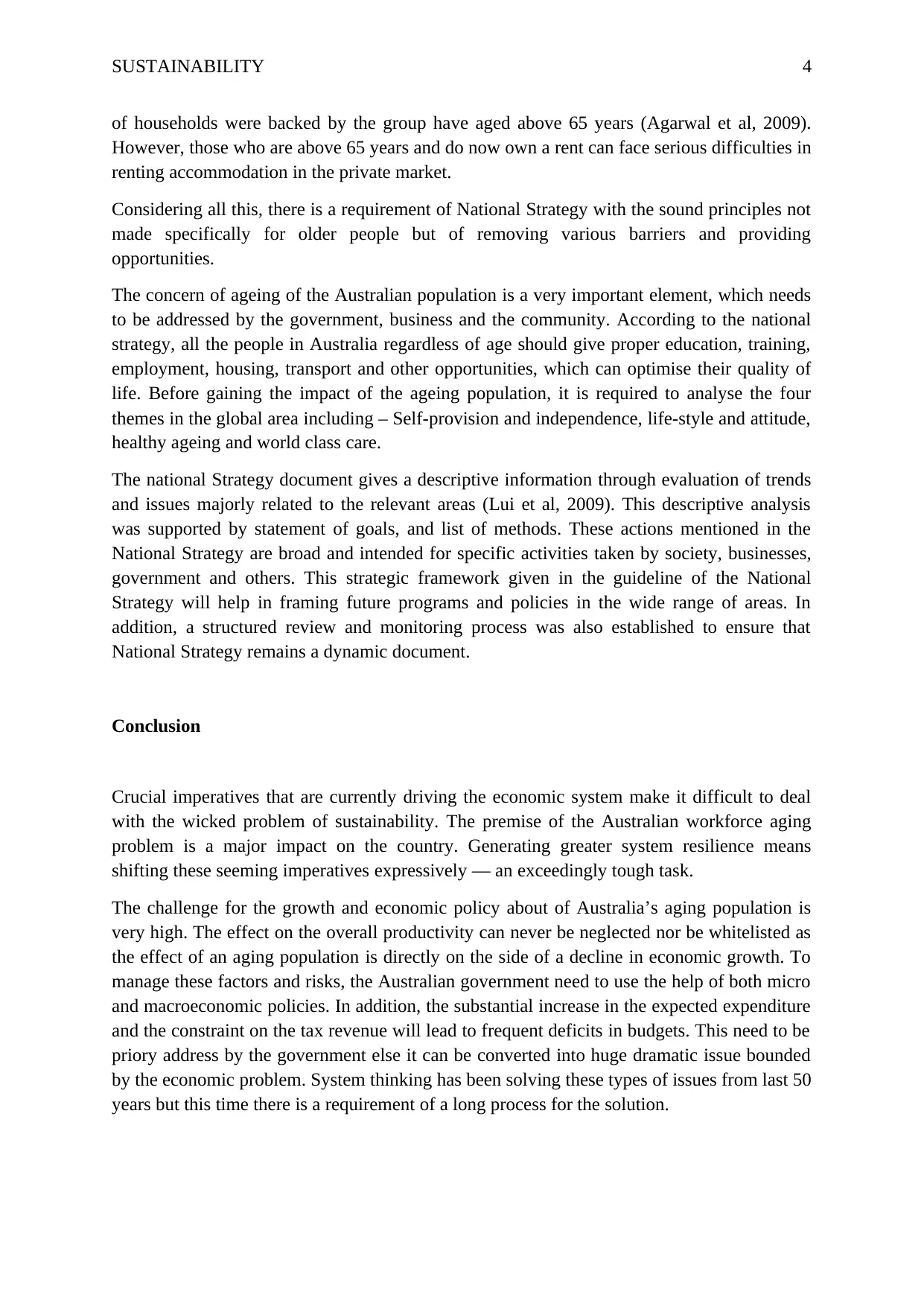
SUSTAINABILITY 4
of households were backed by the group have aged above 65 years (Agarwal et al, 2009).
However, those who are above 65 years and do now own a rent can face serious difficulties in
renting accommodation in the private market.
Considering all this, there is a requirement of National Strategy with the sound principles not
made specifically for older people but of removing various barriers and providing
opportunities.
The concern of ageing of the Australian population is a very important element, which needs
to be addressed by the government, business and the community. According to the national
strategy, all the people in Australia regardless of age should give proper education, training,
employment, housing, transport and other opportunities, which can optimise their quality of
life. Before gaining the impact of the ageing population, it is required to analyse the four
themes in the global area including – Self-provision and independence, life-style and attitude,
healthy ageing and world class care.
The national Strategy document gives a descriptive information through evaluation of trends
and issues majorly related to the relevant areas (Lui et al, 2009). This descriptive analysis
was supported by statement of goals, and list of methods. These actions mentioned in the
National Strategy are broad and intended for specific activities taken by society, businesses,
government and others. This strategic framework given in the guideline of the National
Strategy will help in framing future programs and policies in the wide range of areas. In
addition, a structured review and monitoring process was also established to ensure that
National Strategy remains a dynamic document.
Conclusion
Crucial imperatives that are currently driving the economic system make it difficult to deal
with the wicked problem of sustainability. The premise of the Australian workforce aging
problem is a major impact on the country. Generating greater system resilience means
shifting these seeming imperatives expressively — an exceedingly tough task.
The challenge for the growth and economic policy about of Australia’s aging population is
very high. The effect on the overall productivity can never be neglected nor be whitelisted as
the effect of an aging population is directly on the side of a decline in economic growth. To
manage these factors and risks, the Australian government need to use the help of both micro
and macroeconomic policies. In addition, the substantial increase in the expected expenditure
and the constraint on the tax revenue will lead to frequent deficits in budgets. This need to be
priory address by the government else it can be converted into huge dramatic issue bounded
by the economic problem. System thinking has been solving these types of issues from last 50
years but this time there is a requirement of a long process for the solution.
of households were backed by the group have aged above 65 years (Agarwal et al, 2009).
However, those who are above 65 years and do now own a rent can face serious difficulties in
renting accommodation in the private market.
Considering all this, there is a requirement of National Strategy with the sound principles not
made specifically for older people but of removing various barriers and providing
opportunities.
The concern of ageing of the Australian population is a very important element, which needs
to be addressed by the government, business and the community. According to the national
strategy, all the people in Australia regardless of age should give proper education, training,
employment, housing, transport and other opportunities, which can optimise their quality of
life. Before gaining the impact of the ageing population, it is required to analyse the four
themes in the global area including – Self-provision and independence, life-style and attitude,
healthy ageing and world class care.
The national Strategy document gives a descriptive information through evaluation of trends
and issues majorly related to the relevant areas (Lui et al, 2009). This descriptive analysis
was supported by statement of goals, and list of methods. These actions mentioned in the
National Strategy are broad and intended for specific activities taken by society, businesses,
government and others. This strategic framework given in the guideline of the National
Strategy will help in framing future programs and policies in the wide range of areas. In
addition, a structured review and monitoring process was also established to ensure that
National Strategy remains a dynamic document.
Conclusion
Crucial imperatives that are currently driving the economic system make it difficult to deal
with the wicked problem of sustainability. The premise of the Australian workforce aging
problem is a major impact on the country. Generating greater system resilience means
shifting these seeming imperatives expressively — an exceedingly tough task.
The challenge for the growth and economic policy about of Australia’s aging population is
very high. The effect on the overall productivity can never be neglected nor be whitelisted as
the effect of an aging population is directly on the side of a decline in economic growth. To
manage these factors and risks, the Australian government need to use the help of both micro
and macroeconomic policies. In addition, the substantial increase in the expected expenditure
and the constraint on the tax revenue will lead to frequent deficits in budgets. This need to be
priory address by the government else it can be converted into huge dramatic issue bounded
by the economic problem. System thinking has been solving these types of issues from last 50
years but this time there is a requirement of a long process for the solution.
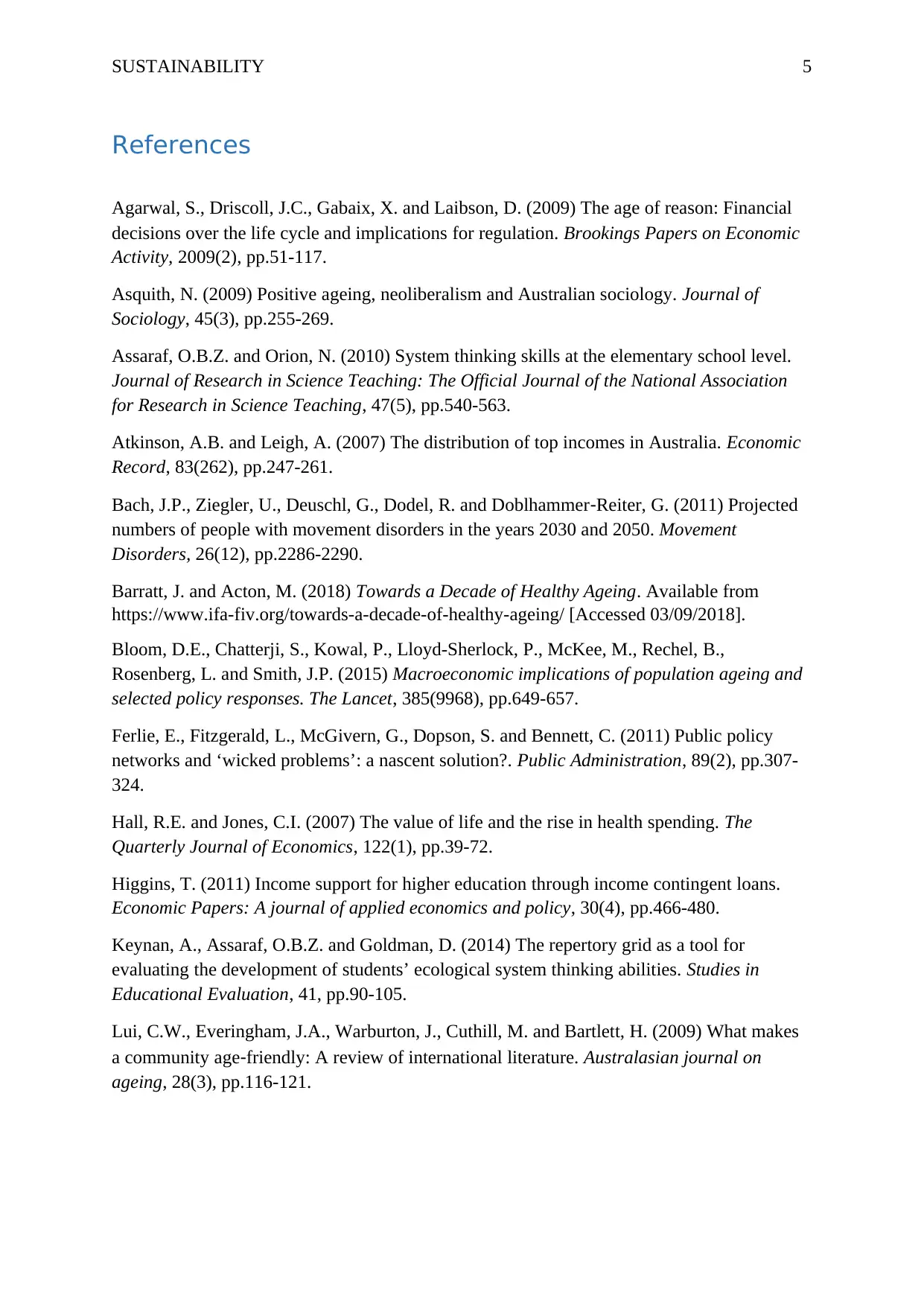
SUSTAINABILITY 5
References
Agarwal, S., Driscoll, J.C., Gabaix, X. and Laibson, D. (2009) The age of reason: Financial
decisions over the life cycle and implications for regulation. Brookings Papers on Economic
Activity, 2009(2), pp.51-117.
Asquith, N. (2009) Positive ageing, neoliberalism and Australian sociology. Journal of
Sociology, 45(3), pp.255-269.
Assaraf, O.B.Z. and Orion, N. (2010) System thinking skills at the elementary school level.
Journal of Research in Science Teaching: The Official Journal of the National Association
for Research in Science Teaching, 47(5), pp.540-563.
Atkinson, A.B. and Leigh, A. (2007) The distribution of top incomes in Australia. Economic
Record, 83(262), pp.247-261.
Bach, J.P., Ziegler, U., Deuschl, G., Dodel, R. and Doblhammer‐Reiter, G. (2011) Projected
numbers of people with movement disorders in the years 2030 and 2050. Movement
Disorders, 26(12), pp.2286-2290.
Barratt, J. and Acton, M. (2018) Towards a Decade of Healthy Ageing. Available from
https://www.ifa-fiv.org/towards-a-decade-of-healthy-ageing/ [Accessed 03/09/2018].
Bloom, D.E., Chatterji, S., Kowal, P., Lloyd-Sherlock, P., McKee, M., Rechel, B.,
Rosenberg, L. and Smith, J.P. (2015) Macroeconomic implications of population ageing and
selected policy responses. The Lancet, 385(9968), pp.649-657.
Ferlie, E., Fitzgerald, L., McGivern, G., Dopson, S. and Bennett, C. (2011) Public policy
networks and ‘wicked problems’: a nascent solution?. Public Administration, 89(2), pp.307-
324.
Hall, R.E. and Jones, C.I. (2007) The value of life and the rise in health spending. The
Quarterly Journal of Economics, 122(1), pp.39-72.
Higgins, T. (2011) Income support for higher education through income contingent loans.
Economic Papers: A journal of applied economics and policy, 30(4), pp.466-480.
Keynan, A., Assaraf, O.B.Z. and Goldman, D. (2014) The repertory grid as a tool for
evaluating the development of students’ ecological system thinking abilities. Studies in
Educational Evaluation, 41, pp.90-105.
Lui, C.W., Everingham, J.A., Warburton, J., Cuthill, M. and Bartlett, H. (2009) What makes
a community age‐friendly: A review of international literature. Australasian journal on
ageing, 28(3), pp.116-121.
References
Agarwal, S., Driscoll, J.C., Gabaix, X. and Laibson, D. (2009) The age of reason: Financial
decisions over the life cycle and implications for regulation. Brookings Papers on Economic
Activity, 2009(2), pp.51-117.
Asquith, N. (2009) Positive ageing, neoliberalism and Australian sociology. Journal of
Sociology, 45(3), pp.255-269.
Assaraf, O.B.Z. and Orion, N. (2010) System thinking skills at the elementary school level.
Journal of Research in Science Teaching: The Official Journal of the National Association
for Research in Science Teaching, 47(5), pp.540-563.
Atkinson, A.B. and Leigh, A. (2007) The distribution of top incomes in Australia. Economic
Record, 83(262), pp.247-261.
Bach, J.P., Ziegler, U., Deuschl, G., Dodel, R. and Doblhammer‐Reiter, G. (2011) Projected
numbers of people with movement disorders in the years 2030 and 2050. Movement
Disorders, 26(12), pp.2286-2290.
Barratt, J. and Acton, M. (2018) Towards a Decade of Healthy Ageing. Available from
https://www.ifa-fiv.org/towards-a-decade-of-healthy-ageing/ [Accessed 03/09/2018].
Bloom, D.E., Chatterji, S., Kowal, P., Lloyd-Sherlock, P., McKee, M., Rechel, B.,
Rosenberg, L. and Smith, J.P. (2015) Macroeconomic implications of population ageing and
selected policy responses. The Lancet, 385(9968), pp.649-657.
Ferlie, E., Fitzgerald, L., McGivern, G., Dopson, S. and Bennett, C. (2011) Public policy
networks and ‘wicked problems’: a nascent solution?. Public Administration, 89(2), pp.307-
324.
Hall, R.E. and Jones, C.I. (2007) The value of life and the rise in health spending. The
Quarterly Journal of Economics, 122(1), pp.39-72.
Higgins, T. (2011) Income support for higher education through income contingent loans.
Economic Papers: A journal of applied economics and policy, 30(4), pp.466-480.
Keynan, A., Assaraf, O.B.Z. and Goldman, D. (2014) The repertory grid as a tool for
evaluating the development of students’ ecological system thinking abilities. Studies in
Educational Evaluation, 41, pp.90-105.
Lui, C.W., Everingham, J.A., Warburton, J., Cuthill, M. and Bartlett, H. (2009) What makes
a community age‐friendly: A review of international literature. Australasian journal on
ageing, 28(3), pp.116-121.
⊘ This is a preview!⊘
Do you want full access?
Subscribe today to unlock all pages.

Trusted by 1+ million students worldwide
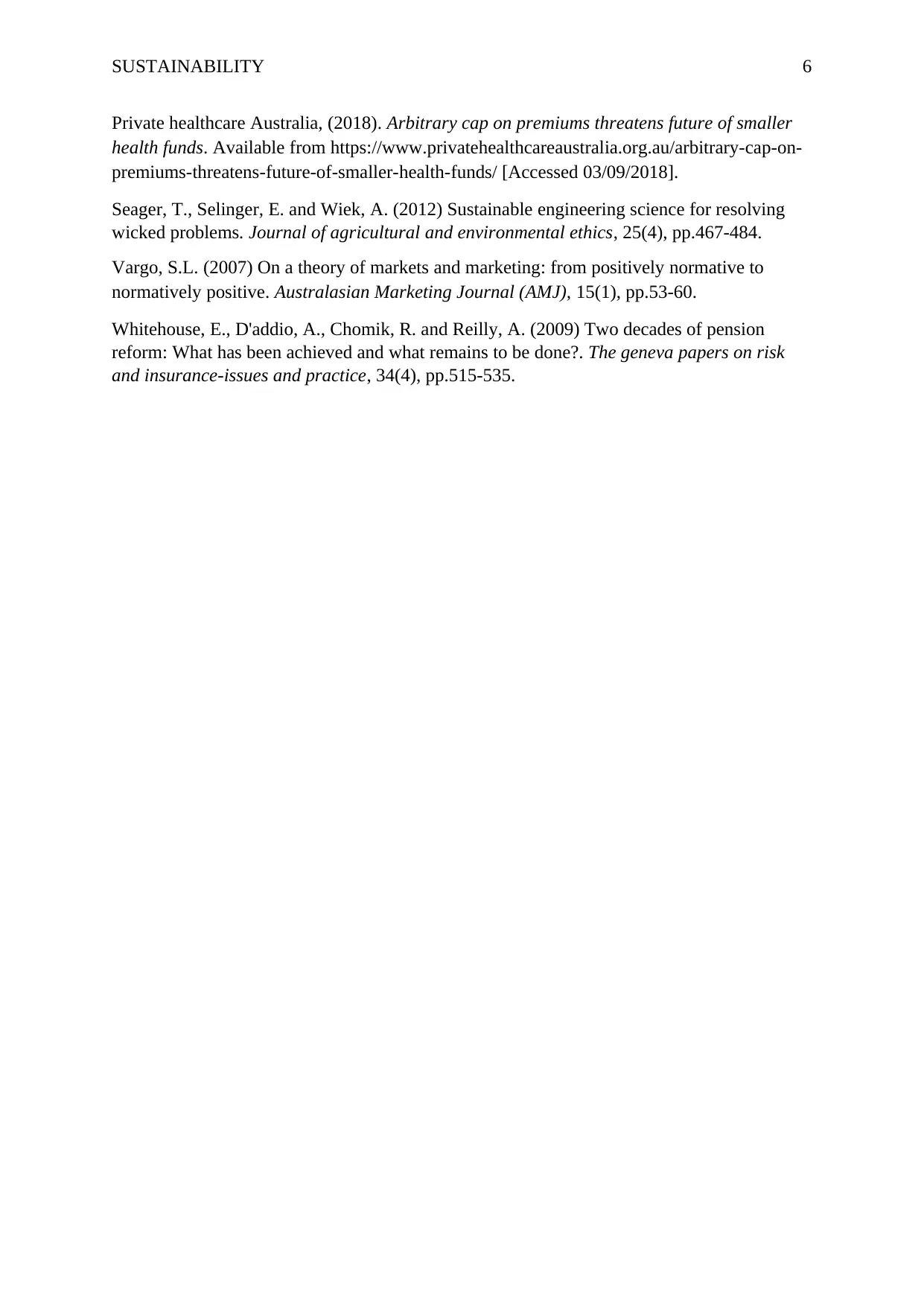
SUSTAINABILITY 6
Private healthcare Australia, (2018). Arbitrary cap on premiums threatens future of smaller
health funds. Available from https://www.privatehealthcareaustralia.org.au/arbitrary-cap-on-
premiums-threatens-future-of-smaller-health-funds/ [Accessed 03/09/2018].
Seager, T., Selinger, E. and Wiek, A. (2012) Sustainable engineering science for resolving
wicked problems. Journal of agricultural and environmental ethics, 25(4), pp.467-484.
Vargo, S.L. (2007) On a theory of markets and marketing: from positively normative to
normatively positive. Australasian Marketing Journal (AMJ), 15(1), pp.53-60.
Whitehouse, E., D'addio, A., Chomik, R. and Reilly, A. (2009) Two decades of pension
reform: What has been achieved and what remains to be done?. The geneva papers on risk
and insurance-issues and practice, 34(4), pp.515-535.
Private healthcare Australia, (2018). Arbitrary cap on premiums threatens future of smaller
health funds. Available from https://www.privatehealthcareaustralia.org.au/arbitrary-cap-on-
premiums-threatens-future-of-smaller-health-funds/ [Accessed 03/09/2018].
Seager, T., Selinger, E. and Wiek, A. (2012) Sustainable engineering science for resolving
wicked problems. Journal of agricultural and environmental ethics, 25(4), pp.467-484.
Vargo, S.L. (2007) On a theory of markets and marketing: from positively normative to
normatively positive. Australasian Marketing Journal (AMJ), 15(1), pp.53-60.
Whitehouse, E., D'addio, A., Chomik, R. and Reilly, A. (2009) Two decades of pension
reform: What has been achieved and what remains to be done?. The geneva papers on risk
and insurance-issues and practice, 34(4), pp.515-535.
1 out of 7
Related Documents
Your All-in-One AI-Powered Toolkit for Academic Success.
+13062052269
info@desklib.com
Available 24*7 on WhatsApp / Email
![[object Object]](/_next/static/media/star-bottom.7253800d.svg)
Unlock your academic potential
Copyright © 2020–2025 A2Z Services. All Rights Reserved. Developed and managed by ZUCOL.





